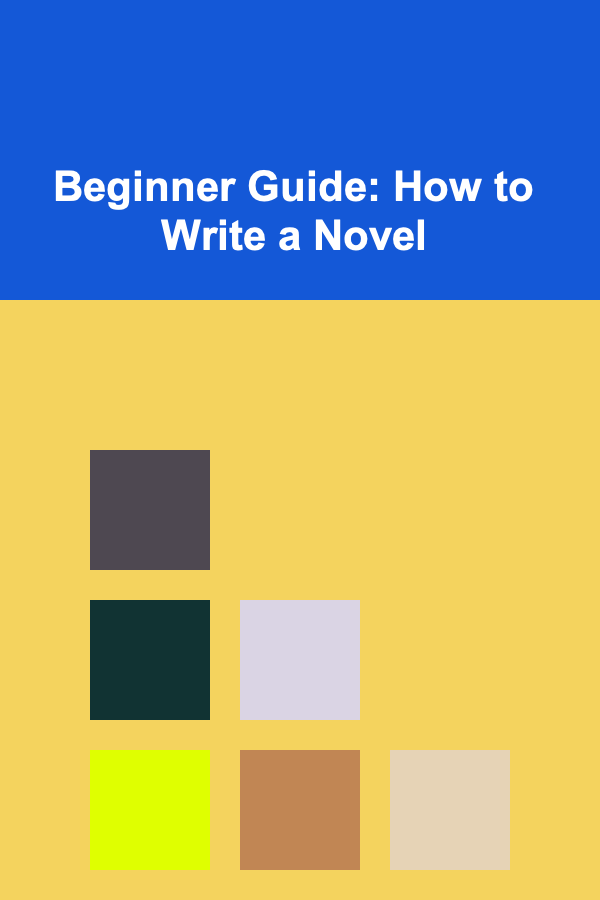
Beginner Guide: How to Write a Novel
ebook include PDF & Audio bundle (Micro Guide)
$12.99$5.99
Limited Time Offer! Order within the next:

Writing a novel is a complex yet incredibly rewarding endeavor. Whether you're inspired by a sudden spark of creativity or have been dreaming of completing a book for years, embarking on the journey of writing a novel can feel both daunting and exciting. While there's no one-size-fits-all formula for novel writing, understanding the process and breaking it down into manageable steps can help you stay motivated and focused.
This guide is designed to take you from the initial idea to completing your manuscript, offering practical advice and insights for every stage of the writing process.
Step 1: Find Your Inspiration and Define Your Story
Before you sit down to write, you need to have a clear sense of your novel's foundation. While inspiration can come from many places---personal experiences, dreams, history, or even simple "what-if" questions---this step is about refining the initial spark into something concrete.
1.1 Brainstorm Ideas
Start by asking yourself what excites you most about writing a novel. It could be a genre (e.g., fantasy, romance, historical fiction) or a particular theme (e.g., love, betrayal, personal growth). Write down any and all ideas, no matter how vague or unconventional. The goal is to have raw material that you can later refine.
Tips for Idea Generation:
- Use Prompts: Look for writing prompts online or in books. These can be simple questions or scenarios to spark your imagination.
- Research: Reading books in your preferred genre or watching movies with similar themes can offer inspiration.
- Personal Experience: Think about moments in your own life that have had a strong emotional impact. Could they form the basis of a novel?
1.2 Define Your Genre
Choosing a genre can significantly shape the style and structure of your novel. Genres such as fantasy, mystery, and romance each have their own conventions and expectations. Understanding these conventions will help you create a novel that meets readers' expectations while giving you the freedom to put your unique spin on it.
1.3 Create a Premise
Once you've gathered a pool of ideas, it's time to define your story more concretely. The premise should be a brief summary of what the novel is about, usually one or two sentences long. This will serve as your novel's guiding principle and help you stay focused.
Example Premise:
- "A young girl discovers she is a witch and must navigate a world of magic and danger to save her family."
Step 2: Develop Characters
Characters are the heart of your novel. Whether you're writing an epic fantasy or a contemporary drama, it's the characters who will drive the plot and make your readers care about the story.
2.1 Create Complex Characters
Begin by developing your protagonist and other key characters. A strong protagonist should have clear goals, motivations, and challenges. Think about their internal and external conflicts---what do they want, and what's standing in their way?
Consider their backstories, personalities, desires, and fears. A good character is multi-dimensional, with both strengths and flaws that make them relatable and interesting.
2.2 Use the "Character Arc"
A character arc refers to the transformation your protagonist undergoes throughout the novel. Most successful characters change in some way, whether emotionally, intellectually, or morally. A well-executed character arc will help make your novel feel satisfying.
Example:
- A protagonist might begin the story feeling weak or insecure but by the end, through trials and challenges, they've learned to embrace their strengths and face their fears.
2.3 Supporting Characters
While the protagonist is crucial, supporting characters (such as the antagonist, love interests, mentors, or friends) help round out the story. Develop their personalities and motivations as well. Even side characters should have a purpose and contribute to the plot or theme in some way.
Step 3: Build the World
The setting of your novel can be just as important as the characters themselves. Whether you're writing a realistic story set in the modern world or a high-fantasy tale with complex worlds and magic systems, the setting should serve your story and immerse readers.
3.1 Develop Your Setting
Think about the environment in which your story takes place. Consider how the setting influences the characters' actions, attitudes, and struggles. A dystopian future, for example, will require different dynamics than a small-town romance.
- Physical Description: Describe the physical attributes of the world---its landscapes, buildings, weather, and culture. These details should be vivid but also functional; don't overload your writing with unnecessary descriptions.
- Atmosphere: What is the overall tone of the setting? Is it dark and oppressive or bright and cheerful? The atmosphere should mirror the emotional tone of the story.
3.2 Establish Rules (for Fantasy/Sci-Fi)
If you're writing fantasy, science fiction, or any genre involving elements of magic, technology, or the supernatural, make sure to establish clear rules for how these elements work. Consistency in world-building is key to creating a believable and immersive universe.
Example:
- In a fantasy world, magic might be a limited resource, with consequences for using it recklessly. Your characters will need to navigate these rules as they try to achieve their goals.
Step 4: Create an Outline or Plan
Now that you have a premise, characters, and world, it's time to organize your ideas. Some writers prefer to plan meticulously, while others dive right into writing without a plan. Both approaches have their merits, but having a rough outline can help you stay on track and prevent writer's block.
4.1 Choose Your Outline Method
There are several ways to outline a novel, depending on your writing style and preferences:
- The Snowflake Method: Start with a simple idea and expand it gradually, adding layers of detail with each step. This is a step-by-step approach that builds on itself.
- The Three-Act Structure: Divide your story into three parts: the setup, the conflict, and the resolution. This structure is widely used in film and literature.
- Chapter-by-Chapter Outline: Write a brief description of what happens in each chapter. This method is straightforward and gives you a clear roadmap.
4.2 Plan Key Scenes
Once you have your outline, focus on planning the key scenes in your novel. These are the moments that will propel the story forward and be critical to character development. Think about the pivotal scenes, including the opening scene, major conflicts, and the climax.
Step 5: Start Writing
With everything in place, it's time to start writing. While it can be intimidating to face that blank page, remember that the most important thing is to start---and keep going. Here are some tips to make the writing process smoother:
5.1 Set Realistic Goals
Set manageable daily or weekly writing goals. This could be a word count (e.g., 500 words per day) or a time commitment (e.g., writing for one hour each day). These small, achievable goals will help you maintain momentum.
5.2 Don't Worry About Perfection
Your first draft doesn't have to be perfect. In fact, it shouldn't be. The goal of your first draft is simply to get the story down on paper. You can always revise and improve later. Focus on getting through the rough stages, and allow yourself to make mistakes.
5.3 Embrace Writer's Block
If you hit a wall, don't panic. Take a break, try freewriting, or skip ahead to a scene you're excited about. Sometimes, stepping away from the story for a little while can help you come back with fresh ideas.
Step 6: Revise and Edit
After you finish the first draft, it's time to revise. Editing is where the magic happens, and you'll have the chance to polish your writing, deepen your characters, and refine the plot.
6.1 Take a Break Before Revising
Once the first draft is done, give yourself some distance from it. It can be difficult to edit immediately after completing a draft because you're too close to the material. A few days (or even weeks) away from your manuscript will allow you to come back with fresh eyes.
6.2 Structural Edits
Begin by focusing on big-picture issues: pacing, plot structure, character arcs, and overall story flow. This is the stage where you might cut entire sections, add new material, or completely rework parts of the story to ensure it makes sense.
6.3 Line Editing
Once the structure is solid, move on to line editing. This is where you'll focus on sentence structure, word choice, grammar, and style. Look for redundancies, awkward phrasing, or areas where the language can be tightened up.
6.4 Proofreading
After the major edits are done, do a final proofreading to catch any remaining spelling or grammatical errors. You might also consider using software tools like Grammarly or hiring a professional proofreader to ensure your manuscript is as polished as possible.
Step 7: Publish or Submit
Once you're satisfied with your novel, it's time to share it with the world. Depending on your goals, you have several options for publication:
7.1 Traditional Publishing
If you want to go the traditional route, you'll need to query literary agents or publishers. This process involves writing a query letter and submitting a proposal. Be prepared for rejection, but don't be discouraged---it's a part of the process.
7.2 Self-Publishing
If you prefer more control over the process, self-publishing is a viable option. Platforms like Amazon Kindle Direct Publishing (KDP) or IngramSpark allow you to publish and distribute your novel as an e-book or print-on-demand paperback.
Conclusion
Writing a novel is a journey that requires dedication, creativity, and patience. By breaking down the process into manageable steps---finding your inspiration, developing characters, planning your story, writing, and revising---you can make your dream of writing a novel a reality. Stay consistent, embrace the challenges, and remember that every great writer was once a beginner. Keep writing, and most importantly, enjoy the process!
Reading More From Our Other Websites
- [Home Space Saving 101] How to Maximize Space in Your Entryway with Smart Storage Solutions
- [Screen Printing Tip 101] Best Heat‑Transfer Integration Strategies for Mixed‑Media Screen Printing Designs
- [Organization Tip 101] How to Use a Capsule Wardrobe for Closet Simplification
- [Home Holiday Decoration 101] How to Transform Your Living Room into a Festive Holiday Haven
- [Star Gazing Tip 101] Star-Gazing 2.0: Incorporating Technology and Tradition for a Modern Night-Sky Journey
- [Personal Care Tips 101] How to Create an Eco-Friendly Shower Routine with Body Wash
- [Home Maintenance 101] How to Take Care of Your Home's Insulation for Energy Savings
- [Organization Tip 101] How to Design a Custom Pet Area That Fits Your Lifestyle
- [Horseback Riding Tip 101] From Walk to Trot: Step-by-Step Progressions for New Riders
- [Home Soundproofing 101] How to Build a Home Music Studio with Top Soundproofing Techniques

How to Create a Routine for Regular Equipment Maintenance
Read More
How to Explore Blockchain for Identity Verification
Read More
How to Throw a Party with a Plan: Step-by-Step Guide
Read More
How to Understand the Science of Hunger and Satiety
Read More
Managing Eczema and Psoriasis with Skincare: A Comprehensive Guide
Read More
10 Tips for Optimizing Plumbing System Energy Efficiency
Read MoreOther Products

How to Create a Routine for Regular Equipment Maintenance
Read More
How to Explore Blockchain for Identity Verification
Read More
How to Throw a Party with a Plan: Step-by-Step Guide
Read More
How to Understand the Science of Hunger and Satiety
Read More
Managing Eczema and Psoriasis with Skincare: A Comprehensive Guide
Read More